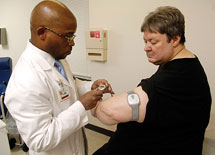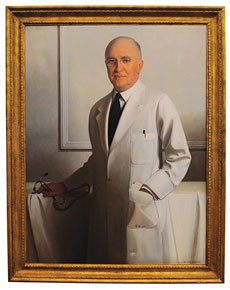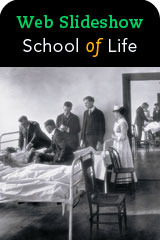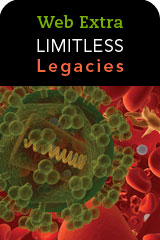Nutrition’s Contributions to Health
By Caperton Gillett
 |
Jamy Ard helps patients understand connections between diet and lifestyle through the EatRight program. |
Pellagra, beriberi, and scurvy are nothing more than vestiges of a distant past in the minds of many Alabamians. But less than a century ago, diseases such as these—caused by nutritional deficiencies—were endemic throughout the state and the Southeast. In the 1920s and ‘30s, two physicians in Birmingham helped turn the tide against malnutrition, and in doing so helped set the School of Medicine and the future UAB on a path to becoming trailblazers in nutrition research, education, and patient care.
The two physicians, James McLester, M.D., and Tom D. Spies, M.D., worked to encourage wider use of the newly discovered vitamins nicotinic acid, thiamin, ascorbic acid, and folic acid to combat the poor diets of many Southerners and the diseases they caused. Spies, in fact, was lauded by Time for discovering that nicotinic acid cures pellagra; he also learned that vitamin B12 corrected megaloblastic anemia of pregnancy, another deficiency disease.
 |
|
James McLester pioneered nutrition treatment and teaching in the 1920s. He later became UAB’s first professor of medicine. |
McLester and Spies found that teaching was one of the best ways to share their knowledge and discoveries, and when the SOM moved to Birmingham, their work inspired countless medical students to study clinical nutrition. Many of these students went on to spread the nutrition gospel through careers in academic medicine—including Walter B. Frommeyer Jr., M.D., who created a Division of Nutrition within the SOM’s Department of Medicine in 1964. Under Charles E. Butterworth Jr., M.D., its first director, the division made major discoveries about the metabolism of folic acid—and its role in treating diseases ranging from rheumatoid arthritis to osteoporosis—and was a pioneer in establishing a course on nutrition for medical students.
Healthy Growth
UAB’s growing focus on nutrition education led to a new Department of Nutrition Sciences in 1977. Chaired by Butterworth, the new unit brought together clinicians and researchers in allied health, medicine, and dentistry. Carol B. Craig, M.S., R.D., founder of the registered dietitian program at University Hospital in 1963, became director of the Division of Human Nutrition and Dietetics as her program was incorporated into the new department.
“The strengths of the department were the faculty and the interdisciplinary nature,” recalls Craig, now a professor emerita. “It was the philosophy of the founders of the department that nutrition could be one of the real strengths of the medical center.” Within the new department, Craig was able to further develop the dietetic internship program and create a master’s program in clinical nutrition. “It was a time of great growth and pioneering approaches to health-care delivery,” she says.
Modern Challenges
Today the department, now shared between the Department of Medicine and the UAB School of Health Professions, continues its research and education tradition by targeting the prevalent problems for 21st-century Alabamians: obesity, diabetes, and hypertension. Department chair Timothy Garvey, M.D., says that an emphasis on metabolism, body composition, genetics, and lifestyle can have the same impact on everyday life that vitamins had 80 years ago.
“There’s convergence among people trying to prevent cancer, people trying to prevent diabetes, people trying to prevent heart disease—it’s all the same thing, and it all involves moderate weight loss, regular exercise, and healthy lifestyles,” Garvey says. “At UAB, we’re realizing this and working together across lines of disease interest at the disease-prevention level in communities.”
Assistant professor Jamy Ard, M.D., says these collaborations have resulted in diet and lifestyle programs for the public such as EatRight and an initiative with UAB Hospital to analyze the nutritional needs of patients. And as always, he adds, the nutrition sciences program focuses on educating the McLesters and Spieses of tomorrow.
“As we go forward, we envision training the next set of professionals, physicians, dietitians, and exercise therapists to help people develop healthy lifestyle patterns so that they can incorporate nutrition, wellness, and prevention into their overall medical plans,” Ard says.

